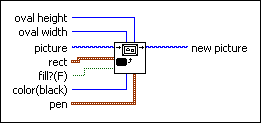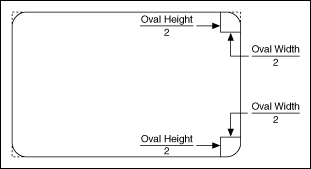Draw Round Rect VI
Owning Palette: Picture Functions VIs
Requires: Base Development System
Draws a rounded rectangle into a picture.

 Add to the block diagram Add to the block diagram |
 Find on the palette Find on the palette |
Owning Palette: Picture Functions VIs
Requires: Base Development System
Draws a rounded rectangle into a picture.

 Add to the block diagram Add to the block diagram |
 Find on the palette Find on the palette |
 |
oval height is the height of an oval that defines the amount of curvature for the corners. | ||||||||||||||
 |
oval width is the width of an oval that defines the amount of curvature for the corners. | ||||||||||||||
 |
picture is the picture to which you want to add the rectangle. The default is an empty picture. | ||||||||||||||
 |
rect is a cluster that contains four numeric controls that describe the left, top, right, and bottom coordinates of the outer edges of a rectangle that circumscribes the rounded rectangle. Horizontal coordinates increase to the right, and vertical coordinates increase to the bottom.
| ||||||||||||||
 |
fill? specifies whether to fill the interior. If FALSE (default), the VI draws only the outlines. | ||||||||||||||
 |
color is the color of the lines. If the interior is filled, the VI uses this color for the interior. The default is black. You can wire a color box constant to this input. |
||||||||||||||
 |
pen sets the width and style of the pen the VI uses to draw the picture.
| ||||||||||||||
 |
new picture is the picture that contains the new image. You can wire this output to any other picture input to add more drawing instructions to the picture. You also can wire this output to the Picture to Pixmap VI to obtain an image data cluster. You then can use the Graphics Formats VIs to save the image data to a file. You can wire this output to the Concatenate Strings function to concatenate the output from multiple Picture Functions VIs so that they draw on a single picture control. |
If oval height and oval width are zero, you get a normal rectangle. If they are greater than zero, they describe how the corners of the rectangle should be rounded, as shown in the following illustration.
